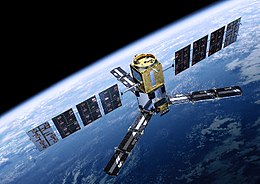 Artist's view of SMOS | |
| Mission type | Earth observation |
|---|---|
| Operator | ESA |
| COSPAR ID | 2009-059A |
| SATCAT no. | 36036 |
| Website | www |
| Mission duration | Planned: 3 years Elapsed: 15 years, 4 days |
| Spacecraft properties | |
| Bus | Proteus |
| Manufacturer | Thales Alenia Space CNES |
| Launch mass | 658 kilograms (1,451 lb) |
| Dry mass | 630 kilograms (1,390 lb) |
| Dimensions | 2.4 by 2.3 metres (7.9 ft × 7.5 ft) (diameter) |
| Power | up to 1065 watts |
| Start of mission | |
| Launch date | 2 November 2009, 14:21:00 UTC[1] |
| Rocket | Rokot/Briz-KM |
| Launch site | Plesetsk 133/3 |
| Contractor | Eurockot |
| Orbital parameters | |
| Reference system | Geocentric |
| Regime | Sun-synchronous |
| Perigee altitude | 765 kilometres (475 mi)[2] |
| Apogee altitude | 766 kilometres (476 mi)[2] |
| Inclination | 98.44 degrees[2] |
| Period | 100.02 minutes[2] |
| Repeat interval | 23 days |
| Epoch | 25 January 2015, 00:45:13 UTC[2] |
| Transponders | |
| Band | S Band (TT&C support) X Band (science data acquisition) |
| Bandwidth | up to 722 kbit/s download (S Band) up to 18.4 Mbit/s download (X Band) up to 4 kbit /s upload (S Band) |
| Instruments | |
| MIRAS: Microwave Imaging Radiometer using Aperture Synthesis | |

| |
Soil Moisture and Ocean Salinity (SMOS) is a satellite which forms part of ESA's Living Planet Programme. It is intended to provide new insights into Earth's water cycle and climate. In addition, it is intended to provide improved weather forecasting and monitoring of snow and ice accumulation.[3][4][5][6]
- ^ "Two new ESA satellites successfully lofted into orbit". ESA. 2009-11-01. Retrieved 2013-10-18.
- ^ a b c d e "SMOS Satellite details 2009-059A NORAD 36036". N2YO. 25 January 2015. Retrieved 25 January 2015.
- ^ ESA's water mission SMOS European Space Agency
- ^ SMOS Project Team, The Soil Moisture and Ocean Salinity (SMOS) Mission Archived 2006-05-06 at the Wayback Machine European Space Agency
- ^ SMOS Special Issue of ESA Bulletin ESA Bulletin Special Issue 137, February 2009
- ^ SMOS: The Challenging Sea Surface Salinity Measurement from Space, J. Font, A. Camps, A. Borges, M. Martin-Neira, J. Boutin, N. Reul, Y. Kerr, A. Hahne and S. Mecklenburg, Proceedings of the IEEE, vol. 98, no. 5, May 2010, pp. 649-665